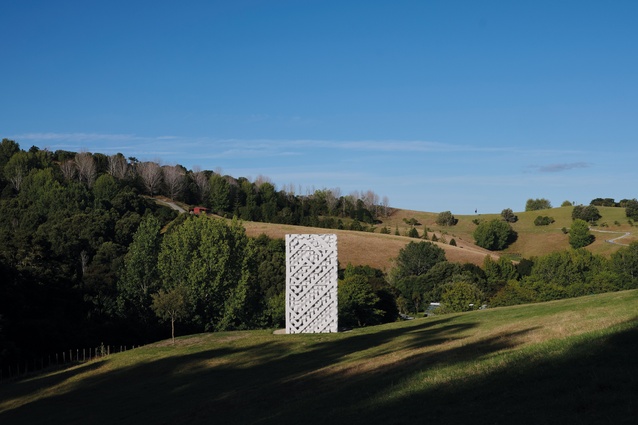[ad_1]
The 2020 Brick Bay Folly winner walks a line between digital promise and its realised form. It is not the first piece to traverse this route; indeed, it is almost implicit in the competition’s format, appealing as it does to students and recent graduates. So pervasive is the generation of form through digital manipulation that it has become the default lingua franca. And why not? The ability to generate form, to manipulate it through generative parameters and spin a projection around on the screen, or travel within it using a headset, is intoxicating and a sometimes-welcome escape from what early diginauts called ‘the big room’.
Getting the thing built, though, remains a challenge. The gap between the projected and the probable is still struggling to be bridged, even as new printing and milling technologies reach out to receive code from the algorithms. It is just that gap that the Brick Bay Folly challenges students to enter: to take the digital model and discover how contemporary construction practice might deliver it.
The 2020 winner, Genealogy of the Pacific, has an apparently simple premise: that the assembly of units composed of an arrangement of near-identical elements, each given a simple dislocation, can give rise to an object wholly unanticipated by examination of its smallest component piece. Common-sized pieces of 250x50mm radiata timber are cut and drilled to a prescribed pattern, and fixed together in groups of five to form an element that is threaded over a tensioning rod to form a layer in a greater whole.
This alarmingly simple sequence of cutting, nailing and bolting is used to create a square column some six metres tall, marked by the incisions and penetrations resulting from the dislocations of those timber pieces. The effect is to suggest a singular scarified form, the façade incised and puckered, its additive genesis eclipsed by the impact of the completed totem-like structure.
One first encounters the column on entry to the estate and, glimpsed at 50 metres away from the car, it is the meta pattern that is first evident; the flat chevrons against a more complex, three-dimensional ground hint at some sort of implicit coding. Later, as one approaches on foot, it is that incised ground that is more evident and we see repetition, iteration and perforation, which suggests any meaning implied by the chevrons requires greater contemplation to decode.
We are allowed inside. In contrast to the incised exterior, the column’s inner face is flat, the planar walls penetrated by openings that break the surrounding fields, bush and sky into bright, jagged-edged jewels. We see, too, the rawness of timber treated with the attempted precision we might more often see with Lego. The joints have minor misalignments as the vagaries of that soft wood exert themselves. There is a comforting reassurance in this: that somewhere in the conjunction of the digital and painted pinus radiata lies familiarity.
The Folly programme offers the promise of the realisation of a project to its young designers but it’s not a free ride. They are charged with doing all that is necessary to detail, manufacture and erect the project within a tightly defined budget. If the result is a tautly unified whole, its development and construction offered all the challenges of traversing the digital-to-artefact divide and did so while navigating the many challenges Covid threw up.
To assist the programme, the Brick Bay organisers wrap a small coterie of consultants and coordinators around the designers to offer support, commentary and critique. Despite no shortage of advice and warnings of likely pitfalls, it was over to the gang of three to sort things out. We commentators identified issues as basic as the logistics of machining four and a half thousand individual parts, the bolt-tightening methodology, and the health and safety implications of the delivery, unloading and assembly sequence of the partially assembled elements, some weighing up to half a tonne. All were dealt with, and resolved with enthusiasm, thoughtfulness, hard work and the timely input of friends and family.
The Folly programme is a great challenge, the growth in the designers’ knowledge, ability and confidence has been enormous, and the result is a beautiful piece of work that easily realises the potential of the original renders and offers a work that is both enigmatic and suggestive.
Brick Bay Folly is sponsored by Cheshire Architects, Naylor Love, Resene, Unitec, Architecture NZ/ArchitectureNow, Sam Hartnett Photography and Brick Bay.
This year’s judges were Pip Cheshire from Cheshire Architects, Philip Haycock from Naylor Love, Yusef Patel from Unitec, Karen Warman from Resene (represented by Karmen Dumper), Chris Barton from Architecture NZ, Richard and Anna Didsbury from Brick Bay, and Leo Zhu from the 2019 winning Folly team, which created The Wood Pavilion.
[ad_2]
Source link











